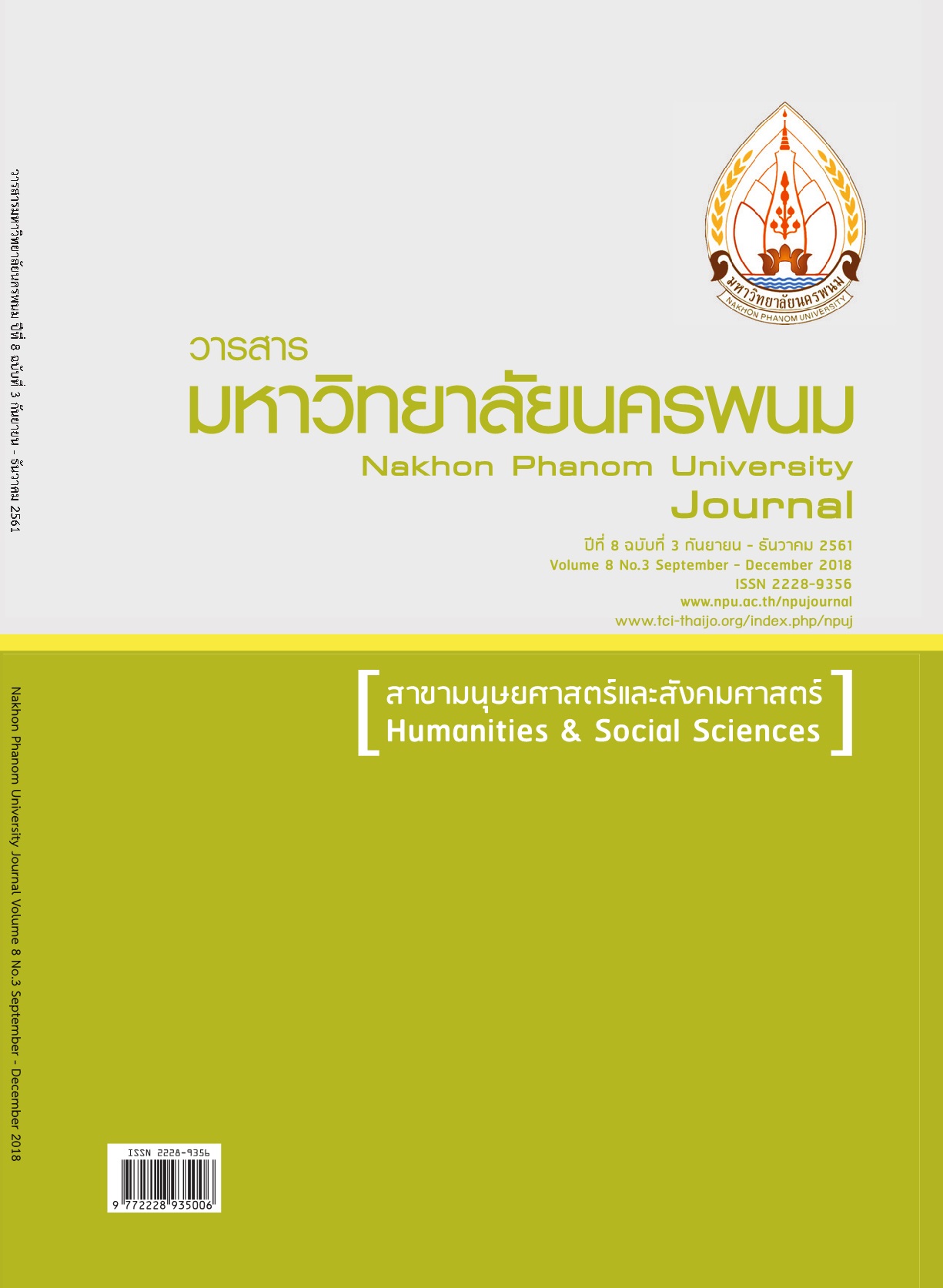The New Model of Teaching Measurement In the School Level Mathematics Course
Main Article Content
Abstract
Most mathematics teachers still use traditional teaching approach that emphasis on lecturing, explaining, remembering and doing exercises. Students do not like mathematics and have low mathematics competency. To solve this problem, teachers need to change their teaching approach to new teaching approach that emphasizes meaningful learning. Lesson Study and Open Approach are new teaching approach that have been widely adopted and adapted to teaching mathematics in Thailand. Mathematics teachers, who want to teach students to learn measurement meaningfully, have to understand the teaching model of measurement. DIAS model is a teaching model of measurement that uses to design for the student to learn Direct comparison (D), Indirect comparison (I), Arbitrary unit (A) and Standard unit (S). The mathematics teacher who implements this new teaching approach and model, students will be able to learn mathematics by themselves, understand the matter of measurement, and apply knowledge to solve measurement problems in everyday life.
Article Details
References
______. (2559). ตัวชี้วัดและสาระการเรียนรู้แกนกลางต้องรู้และควรรู้ กลุ่มสาระการเรียนรู้คณิตศาสตร์ ตามหลักสูตรแกนกลางการศึกษาขั้นพื้นฐาน พุทธศักราช 2551. กรุงเทพฯ : สำนักงานคณะกรรมการการศึกษาขั้นพื้นฐาน.
เจนสมุทร แสงพันธ์. (2555). พัฒนาการของกิจกรรมเชิงสัญญะของนักเรียนผ่านวาทกรรมร่วมในชั้นเรียน คณิตศาสตร์ที่ใช้นวัตกรรมการศึกษาชั้นเรียนและวิธีการแบบเปิด. วิทยานิพนธ์ปริญญาปรัชญาดุษฎีบัณฑิต สาขาวิชาคณิตศาสตรศึกษา บัณฑิตวิทยาลัย มหาวิทยาลัยขอนแก่น.
ญานิน กองทิพย์. (2555). การสื่อสารทางคณิตศาสตร์ด้วยท่าทางในวิธีการแบบเปิด. วิทยานิพนธ์ปริญญาปรัชญาดุษฎีบัณฑิต สาขาวิชาคณิตศาสตรศึกษา บัณฑิตวิทยาลัย มหาวิทยาลัยขอนแก่น.
ไมตรี อินทร์ประสิทธิ์ และ มะซะมิ อิโซดะ. (อยู่ระหว่างจัดพิมพ์). คำอธิบายการใช้หนังสือเรียนคณิตศาสตร์สำหรับระดับชั้นประถมศึกษา ชั้นประถมศึกษาปีที่ 6 เล่ม 1. ขอนแก่น: ศูนย์วิจัยคณิตศาสตรศึกษา.
ไมตรี อินทร์ประสิทธิ์ และคณะ. (2553). คณิตศาสตร์ระดับชั้นประถมศึกษา ชั้นประถมศึกษาปีที่ 1-6 (ฉบับแปลภาษาไทย). ขอนแก่น: คลังนานาวิทยา.
ไมตรี อินทร์ประสิทธิ์. (2557). กระบวนการแก้ปัญหาในคณิตศาสตร์ระดับโรงเรียน. ขอนแก่น: เพ็ญพรินติ้ง.
วิทยากร เชียงกูล. (2559). สภาวะการศึกษาไทย ปี 2557/2558 จะปฏิรูปการศึกษาไทยให้ทันโลกในศตวรรษที่ 21 ได้อย่างไร. กรุงเทพฯ: พิมพ์ดีการพิมพ์.
สถาบันส่งเสริมการสอนวิทยาศาสตร์และเทคโนโลยี. (2555). รายงานผลการวิจัยโครงการ TIMSS 2011 วิชาคณิตศาสตร์. กรุงเทพฯ : สถาบันส่งเสริมการสอนวิทยาศาสตร์และเทคโนโลยี.
สัมพันธ์ ถิ่นเวียงทอง. (2555). การสื่อสารกลุ่มย่อยทางคณิตศาสตร์ในชั้นเรียนภายใต้บริบทของการศึกษาชั้นเรียนและวิธีการแบบเปิด. วิทยานิพนธ์ปริญญาปรัชญาดุษฎีบัณฑิต สาขาวิชาคณิตศาสตรศึกษา บัณฑิตวิทยาลัย มหาวิทยาลัยขอนแก่น.
Bishara, S. (2015). Active and traditional teaching of mathematics in special education. Creative Education, 6, 2313-2324.
Common Core State Standards Initiative. (2017). Common core state standards for mathematics. Retrieved November 2017, from https://www.corestandards.org/assets/CCSSI_Math%20Standards.pdf
Inprasitha, M. (2006). Open-ended approach and teacher education. Paper presented at The Second APEC-Tsukuba International Conference on Innovative Teaching Mathematics trough Lesson Study II- Focusing on Mathematical Thinking. CRICED, University of Tsukuba.
Isoda, M. (2007). A Brief history of mathematics lesson study in Japan. In M. Isoda, M. Stephen, Y. Ohara & T. Miyakawa (Eds.). Japanese lesson study in mathematics: Its impact, diversity and potential for educational improvement. (pp. 8-15). Singapore: World Scientific Publishing.
Lewis, C. (2002). Lesson study: A handbook for teacher-led improvement of instruction. Philadelphia: Research for Better Schools.
Miyakawa, T. (2010). Introducing the unit with comparison : Difference and construction of units. Journal of Japan Society of Mathematical Education, 92(11), 144-145.
National Measurement Office. (2017). Measurement in daily life. Retrieved November 2017, from https://www.npl.co.uk/upload/pdf/measurement-matters.pdf
New Jersey Mathematics Curriculum Framework. (2017). Standard 9-measurment. Retrieved November 2017, from https://www.state.nj.us/education/archive/frameworks/math/math7.pdf
Pasjuso, S., Thinwiangthong, S. & Kongtip, Y. (2010). Comparative study of gesture in mathematical communication in Thai traditional and innovated classrooms. In Y. Shimizu, Y. Sekiguchi & K. Hino (Eds.). Proceedings of the 5th East Asia Regional Conference on Mathematics Education (EARCOME5). Vol. 1. (p. 230). Tokyo, Japan: Inamoto Printing.
Stigler, J., & Hiebert, J., (1999). The teaching gap. New York: The Free Press.
World Association of Lesson Studies. (2017). About WALS. Retrieved November 2017, from https://www.walsnet.org/about-wals.html
Zollner, J. & Benz, C. (2013). How four to six year old children compare length indirectly. Paper Presented at Eighth Congress of European Research in Mathematics Education (CERME 8). Manavgat-Side, Antalya – Turkey.


